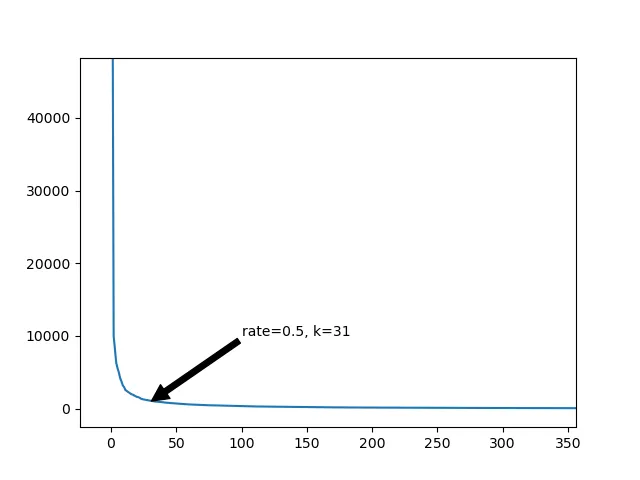667 字
3 分钟
基于SVD的图像压缩算法
理论基础
详见奇异值分解
奇异值分解(SVD)可以将任意矩阵分解为 的形式。并且越靠近后面的项越不重要,去除它们就可以用更小的空间储存一个与原来矩阵相近的矩阵。
若将图像看作RGB三通道的三个矩阵,对图像SVD并保留前项,就可以实现图像压缩。
效果展示&分析

可以看到,当压缩率在0.5以上时,图像基本保持原本的细节,压缩率0.5以下时,逐渐丢失了细节。
画出 曲线。可以看到 随 的增加先急剧降低,后缓慢降低。

代码
Waiting for api.github.com...
import numpy as npimport matplotlib.pyplot as pltimport PIL.Imageimport argparse
def load_img(path): img = PIL.Image.open(path) img = np.array(img).astype('float32') return img
def compress(path, rate): img = load_img(path) img = np.transpose(img, (2, 0, 1)) # (m, n, 3) -> (3, m, n) u, s, v = np.linalg.svd(img) # SVD分解 if rate >= 1: return u, s, v m, n = img.size k = rate_to_k(m, n, rate) return truncate(u, s, v, k)
def truncate(u, s, v, k): # 截断矩阵 u = u[..., :k] # 保留前k列 s = s[:, :k] # 保留前k个奇异值 v = v[:, :k] # 保留前k行 return u, s, v
def rate_to_k(m, n, rate): ''' 设原图像size为m*n 则占用空间为m*n*3 设保留k个奇异值 压缩后占用空间为(m+n+1)*k*3*4 压缩率为rate=(m+n+1)*k*4/(m*n) k = rate*m*n/((m+n+1)*4) ''' return int(rate*m*n/((m+n+1)*4))
def decompress(u, s, v): img = (u * s[:, np.newaxis]) @ v # (3, m, k) * (3, 1, k) @ (3, k, n) -> (3, m, n) img = np.transpose(img, (1, 2, 0)) # (3, m, n) -> (m, n, 3) img = np.round(img.clip(0, 255)).astype('uint8') return img
def preview(path, rates, col=5): row = (len(rates) + col - 1) // col fig, axes = plt.subplots(row, col) for i in axes.flat: i.axis('off') u, s, v = compress(path, 1) m, n = PIL.Image.open(path).size for i, rate in enumerate(rates): k = rate_to_k(m, n, rate) img = decompress(*truncate(u, s, v, k)) ax = axes[i // col, i % col] ax.set_title(f'rate={rate}') ax.imshow(img) plt.show()
def save(path, u, s, v): np.savez_compressed(path, u=u, s=s, v=v)
def load_c(path): d = np.load(path) return d['u'], d['s'], d['v']
def main(): # main里的内容并不重要,这是使用ChatGPT自动生成的命令行界面,便于使用。 parser = argparse.ArgumentParser(description="SVD Image Compression")
# Compression options parser.add_argument('-c', '--compress', metavar='FILE', help='Compress an image') parser.add_argument('-o', '--output', metavar='FILE', help='Specify output file for compression') parser.add_argument('-r', '--rate', type=float, help='Compression rate')
# Decompression options parser.add_argument('-d', '--decompress', metavar='FILE', help='Decompress a compressed file')
# Preview options parser.add_argument('-p', '--preview', metavar='FILE', help='Preview the compressed images') parser.add_argument('--rates', type=float, nargs='+', help='Specify compression rates for preview')
args = parser.parse_args()
if args.compress: u, s, v = compress(args.compress, args.rate or 0.8) output = args.output or args.compress if not output.endswith('.npz'): output += '.npz' save(output, u, s, v) print(f'Image compressed and saved to {output}')
elif args.decompress: u, s, v = load_c(args.decompress) output = args.output or args.decompress if output.endswith('.npz'): output = output[:-4] img = decompress(u, s, v) PIL.Image.fromarray(img).save(output) print(f'Image decompressed and saved to {output}')
elif args.preview: rates = args.rates or [ 1, 0.9, 0.8, 0.7, 0.6, 0.5, 0.4, 0.3, 0.2, 0.1 ] preview(args.preview, rates)
else: parser.print_help()
if __name__ == '__main__': main()